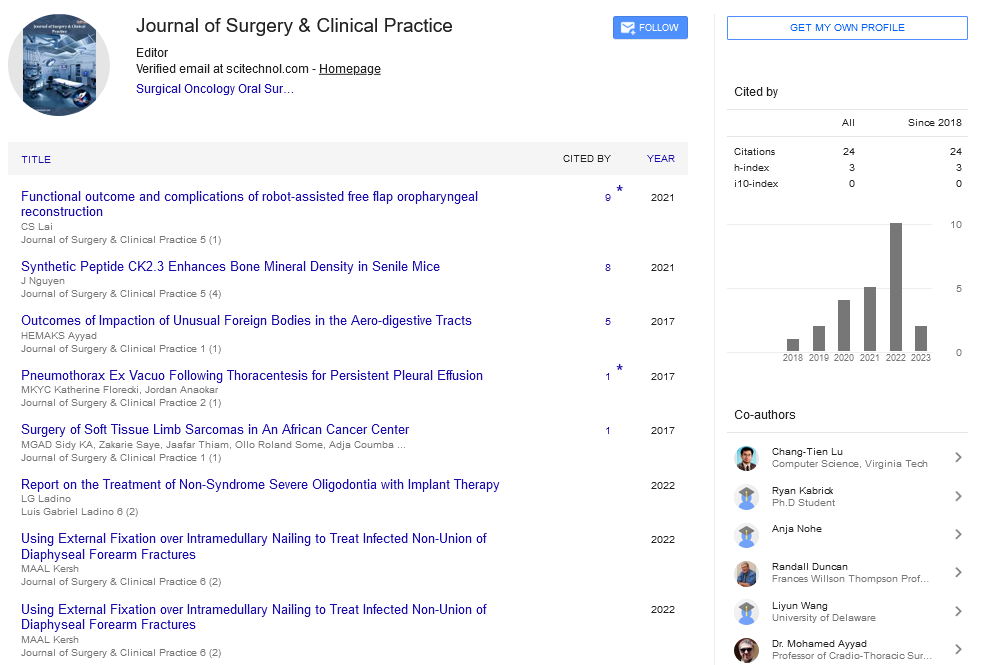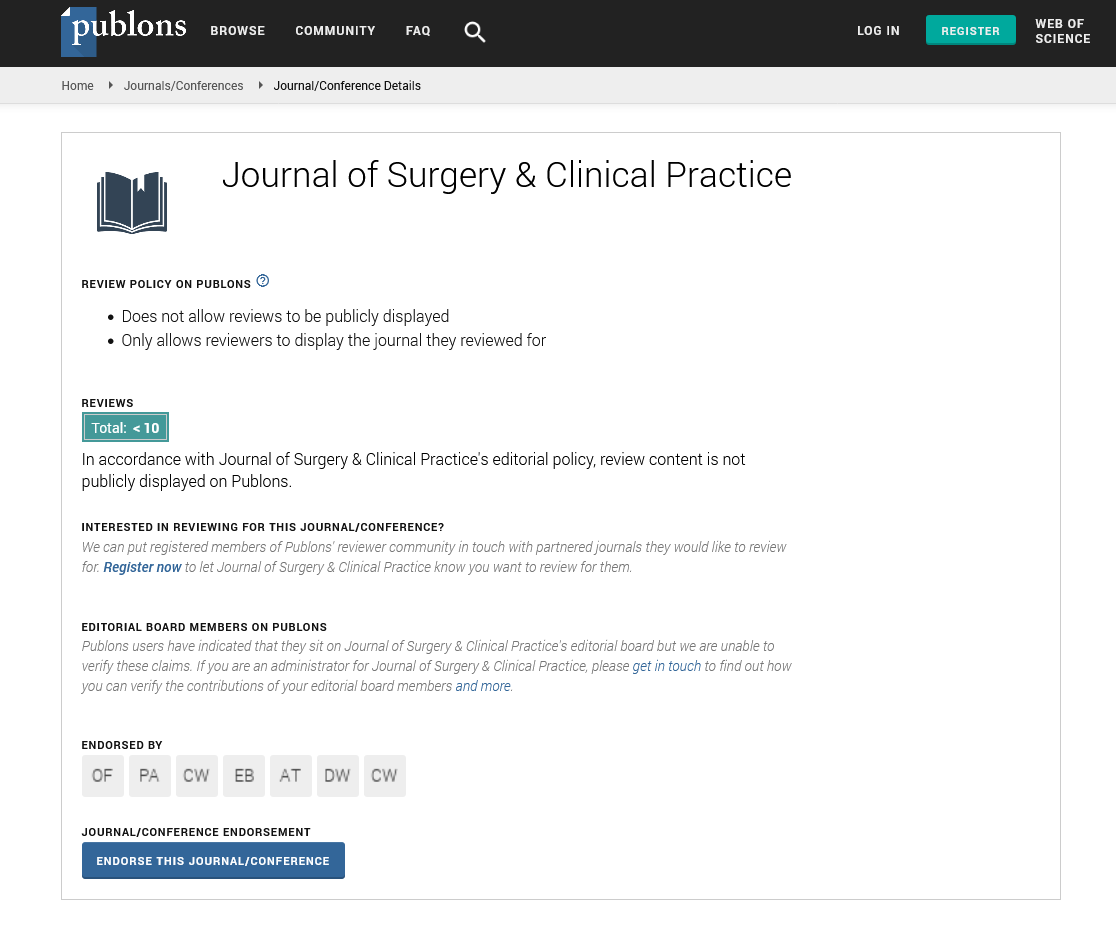Commentary, J Surg Clin Prac Vol: 6 Issue: 3
Cardiac Surgery and Neurosurgery Patients on Variation
Soni Namita*
Department of Medicine, MGM Medical College, Aurangabad, India
*Corresponding Author: Soni Namita
Department of Medicine, MGM Medical College, Aurangabad, India
Email: namitas35@gmail.com
Received date: 18 April, 2022; Manuscript No. JSCP-22-42524;
Editor assigned date: 20 April, 2022; PreQC No. JSCP-22-42524 (PQ);
Reviewed date: 29 April, 2022; QC No. JSCP-22-42524;
Revised date: 09 May, 2022; Manuscript No. JSCP-22-42524 (R);
Published date: 19 May, 2022; DOI: 10.4172/Jscp.1000364
Citation: Namita S (2022) Cardiac Surgery and Neurosurgery Patients on Variation. J Surg Clin Prac 6:3.
Keywords: Neurosurgery
Description
Wolfram pattern (WFS) appertained to as DIDMOAD (Diabetes Insipid us, Diabetes Mellitus, Optic Atrophy, Deafness), originally described in 1938 by Wolfram and Wagener, is a rare neurodegenerative autosomal-sheepish complaint substantially characterized by juvenile onset Diabetes Mellitus (DM) by the age of 7 time and Optic Atrophy (OA) by 11 times of age. Other features include diabetes insipid us, sensor neural hail loss, supplementalneuropathy, ataxia, psychiatric problems, renal tract abnormalities, and bladder-atony. Clinical opinion of WFS was verified by actuality of DM and OA at an early age in the affected cases. WFS can be of; Type 1-mutations in WFS1 gene located at 4p16.1.116 chromosome and Type 2-mutation in WFS2 (CISD2) gene located at chromosome Q22- Q24, of Mitochondrial DNA. Dislocation of the function of Wolfram in, a Trans membrane protein decoded by WFS1, has been plant to beget early apoptosis, counting for progressive beta-cell loss and neuronal degeneration associated with complaint.
Wolfram Syndrome (WFS) is a rare autosomal sheepish complaint with a frequency estimate of 1 in to 1 in grounded on an observation of the frequency of optical atrophy and diabetes mellitus. Maternal consanguinity has been noted and estimated 1 in 350 people carry the genes of WFS. Roughly 200 cases have been described in the scientific literature. Only a many families from Jordan have been plant to have WFS Type 2. WFS1 gene mutations are most common cause plant 85-90 cases worldwide. WFS2 prevalence is plant veritably low as in 3 large natural Jordanian families characterized by juvenileonset diabetes mellitus, optical atrophy, deafness, urinary tract dilatation, bloodied renal function, hypogonadism, and severe gastrointestinal ulcer and bleeding, but not diabetes insipid us.
Case X, a 17- time-old womanish born to anon-consanguineous marriage with full term normal delivery, diagnosed with Diabetes Mellitus (DM) at the age of 5 and has been on split insulin authority since also. Case presented with progressive dimension of vision since 6 months, hail loss since 4 months and polyuria and polydipsia since 4 months when presented to us. Case had all the 4 cardinal features which is needed for the clinical opinion of the Wolfram Syndrome (WFS) Type 1. Case developed Diabetes Mellitus (DM) at the age of 5 times, mean age to develop DM in WFS reported in Barrett study is 6 times. DM may affect from hypothalamic degeneration, although loss of pancreatic β- island cells as part of a specific disfigurement in neuroectodermal amine precursor uptake and decarboxylation derived cells in the pancreas and in the supraoptic and periventricular capitals has also been supposed.
Wolfram Syndrome
Dilation of the urinary tract is observed in 45 of cases which may be secondary to habitual high urine inflow rates (DI) or neuronal degeneration at colorful situations of the urinary tract or agony of the bladder. Our case had polyuria and Post void residual volume by ultrasound imaging is 514.09 ml with bilateral hydronephrosis. Cases with juvenile onset DM and vision loss in early decade of life can be clinically diagnosed as WFS to be verified with Inheritable study and other siblings to be screened. One should keep track of case and regular follow up for tight sugar controls and to descry serious complications which are known to manifest latterly in life like hyperglycemic hyperosmolar hypernatremia coma to avoid poor quality of life and increase survival. Latterly in their life, they're known to suffer from neuron-psychiatric illness similar as depression, schizophrenia and suicidal tendency, thus yearly psychiatric evaluation is necessary. Since examination anxiety can frequently negatively intrude with the performance of the scholars, it's recommended that the scholars identify similar factors through awareness. Feting the problems is the first step in managing it effectively. It's also recommended that scholars consult with a psychologist or a counselor for expert operation. Our special thanks to Dean MGM Medical College and HOD Department of drug for nonstop support and guidance. We're thankful to the case and her parents for being collaborative with regular visits and check-ups though they aren't economically strong enough. Also, special thanks to our platoon for cooperation and arranging the finances by themselves to get the examinations and inheritable study done which case cannot go on her own. According to the largest cohort series to date, neurological symptoms were present in 53 of cases by an average age of 15 times.
The maturity of symptoms were related to the brainstem and cerebellum, specifically, cerebellar ataxia, supplemental neuropathy, cognitive impairment, epilepsy, and incipiently dysarthria, dysphagia, and nystagmus in 10. Brain MRI was abnormal in 54, including atrophy of the mind, cerebellum, and brainstem in these cases is neurological affecting audile whim-whams and its central pathways, degenerative atrophy of the vestibulocochlear capitals and inferior calculi leading to dropped perception of sounds rather than deficiency in transmitting the sound to the whim-whams.
 Spanish
Spanish  Chinese
Chinese  Russian
Russian  German
German  French
French  Japanese
Japanese  Portuguese
Portuguese  Hindi
Hindi 
